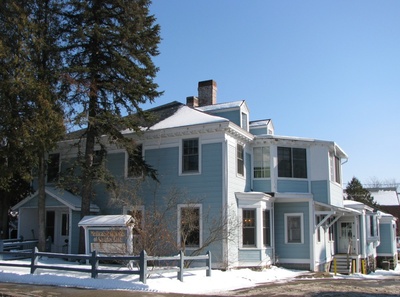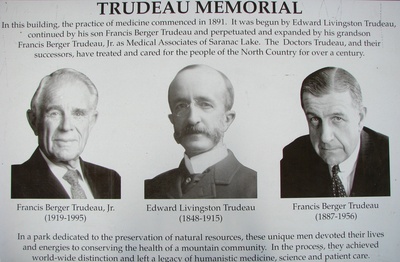 The original Trudeau house, with St. Luke's Church at left
The original Trudeau house, with St. Luke's Church at left
Courtesty of the Adirondack Experience Edward Livingston Trudeau house and office Address: 118 Main Street
Edward Livingston Trudeau house and office Address: 118 Main Street
Old Address: 5 Church Street/105 Main Street
Year built: First house: 1884; Second house: 1894
Architect: J. Lawrence Aspinwall
Other information: Dr. Edward Livingston Trudeau's first house in Saranac Lake was built in 1884; it contained a laboratory. In 1894, a fire in the laboratory destroyed the building. The current residence was built in 1894 on the same site, a Colonial Revival residence designed by Trudeau's cousin, J. Lawrence Aspinwall. The Saranac Laboratory, also designed by Aspinwall, was built the same year, next door to the residence.
The house continued in use as doctors' offices, first for Francis Berger Trudeau and his son Frank, and then as Medical Associates of Saranac Lake, the successor to Frank Trudeau's practice. "It is the oldest continuous medical facility within the blue line," said Dr. Richard Handler (now retired) who was one of Dr. Frank Trudeau's partners.
The practice moved to the Adirondack Medical Center in 2017, and Historic Saranac Lake acquired the building in 2019.
 Adirondack Daily Enterprise, January 12, 1987
Adirondack Daily Enterprise, January 12, 1987  Trudeau memorial Adirondack Daily Enterprise, January 12, 1987
Trudeau memorial Adirondack Daily Enterprise, January 12, 1987
Kerosene incubator caused first home and lab of Dr. Trudeau to burn
In the fall of 1876 Dr. E.L. Trudeau was forced to leave his favored haven at Paul Smith's hotel to search elsewhere for winter quarters. He had spent the previous winter at Paul's and was very reluctant to leave an area that had proved to be so beneficial to his health. Being both a doctor and a consumptive, he realized that the local climate had something to do with his physical improvement. He wanted to spend another winter at Paul Smith's, but Paul had purchased the Fouquet House in Pittsburgh and was moving his staff to that location after closing his own hotel for the season.
Trudeau's first choice was Bloomingdale, but, finding nothing suitable, he moved on to the tiny hamlet of Saranac Lake. In 1876 the settlement was a tiny collection of guide's homes, Milo Miller's grocery store, a sawmill, a school and a hotel for lumbermen. He managed to rent the house belonging to Reuben Reynolds, a local guide, whose place was located near the present site of the Marine Midland Bank. It was here that the Trudeaus spent their first winter in Saranac Lake, little realizing the impact that decision would have on the future of the village.
An avid hunter, Trudeau hunted foxes and rabbits with his two guides, Fitz Greene Hallock and Al McKenzie, and the trio spent many a happy winter's day in the woods. Trudeau kept several hounds, but his favorite pet was a cross between a beagle and a fox-hound which he named "Bunnie." The top winter event was the "big rabbit" contest which created a stir of excitement to break the season's doldrums. It was Bunnie that drove the prize winning hare to his master's stand. The doctor and Fitz, on the very last day of the contest, brought a rabbit to Milo Miller's official scales that weighed four pounds eight and a half ounces, the winner.
Tough existence
In his autobiography Trudeau gives us an insight to living conditions as they were in the 1870's at Saranac Lake. During his second winter in the community, he moved across the street to the Evans cottage which was located where the Newberry's store now stands. For the next seven years the Trudeau family followed a routine pattern of winters at Evans and Summers at Paul Smith's.
Trudeau wrote: "Of course we had no running water in Saranac Lake in those days. A big barrel was kept behind the kitchen stove, from which with a dipper we filled our pitchers, and from time to time Lute Evans would walk down to the river with two pails suspended from a neck-yoke and replenish the barrel." A horse-drawn sleigh brought the mail from AuSable Forks whenever the road was passable. Food consisted mainly of venison, trout and partridge. Once in a while a load of provisions would arrive from the Forks. When the snow was deep, the little hamlet was cut off from the outside world. It was under these conditions that Trudeau gradually began to practice medicine in Saranac Lake.
In 1883 Trudeau decided to build his own house so that his family could better enjoy the winters, and he could have space for a little laboratory in which to conduct his experiments. He was also considering the possibility of a small sanitorium where needy patients could "take the cure." His many friends among the local guides presented him with a parcel of land on the side of Mt. Pisgah near one of his favorite fox runs.
Little Red is built
Here, in 1884, he built "Little Red" the first of the many cottages that were destined to become famous the world over as the "Adirondack Sanitorium." His many wealthy associates from the St. Regis Lakes became generous supporters of Trudeau's endeavors and the early cottages often carried the names of such donors as Stokes, Lea, Straus, McAlpin, Penfold, Hall and Schiff.
All of this activity attracted international attention and in the fall of 1887 Trudeau's most illustrious patient arrived on the scene. Robert Louis Stevenson came from Scotland to place himself in the doctor's care. Between occasional differences of opinion the two became very good friends.
The doctor disapproved of Stevenson's constant smoking and the author frowned upon the nature of some of Trudeau's experiments. During one visit, Stevenson was invited to inspect the little laboratory in the Trudeau home where tubercular cultures were being processed with the aid of a kerosene-fired incubator. Turning pallid at the sight, Stevenson rushed outside for a breath of fresh air. When the doctor asked what was wrong, the author replied, "Trudeau, your light may be very bright to you, but to me it smells of oil like the devil!" Five years after Stevenson left Saranac Lake this very oil was to cause a disaster.
While working in his little lab, Trudeau devised a thermostat heated by a kerosene lamp because there was no gas or coal available in Saranac Lake. The heat from the wood stove would not last the night. The necessary temperature to support the germ growth was maintained by his homemade apparatus. Later he purchased an imported thermostat-controlled device to replace his own equipment, but it still had to be fueled by kerosene.
Fire strikes
In 1893, while the Trudeaus were away in New York City, the contraption exploded and their home was destroyed by fire. This tragic event was a severe blow to the good doctor who lost not only his house and his laboratory but also an irreplaceable gift from his friend Stevenson. The famous author had presented Trudeau with a complete set of his works in 15 volumes made up in special matched bindings. .On the fly leaf of each book was a hand-written inscription dedicating the various titles in this manner:
For "Dr Jekyll and Mr. Hyde" he wrote; "Trudeau was all the winter at my side! I never spied the nose of Mr. Hyde."
For "Treasure Island" it was: "I could not choose a patron for each one; but this perhaps is chiefly for your son."
Fortunately the inscriptions had been copied and a later edition of the works, containing the dedications, was presented to the Saranac Lake Free Library by the Trudeau family.
Mr. George Cooper had been a patient of Dr. Trudeau's since 1884 when he was sent here from New York by Dr. Loomis. He became very fond of Trudeau and, as a member of the wealthy Paul Smith fraternity, was always supportive during the fund-raising campaigns. When he learned of Trudeau's fire, he immediately pledged the money necessary to build a new and completely fireproof laboratory which became the very first in this country to research the deadly "white plague." The stone building on Church Street outlasted the dread disease. It now serves as an annex to the Paul Smith's College complex surrounding the Hotel Saranac. 1
In her Fifty Years at Trudeau Sanatorium Elizabeth Cole suggests that perhaps the Trudeau fire was a blessing in disguise. Much earlier Dr. William Osler agreed with this sentiment when he wrote:
"Dear Trudeau:
I am sorry to hear of your misfortune, but take my word for it, there is nothing like a fire to make a man do the Phoenix trick."
Dr. Trudeau rebuilt his home which served the offices of both his son and his grandson in the medical profession. Perhaps Cole and Osler were both right.
Plattsburgh Sentinel, December 8, 1893
SARANAC LAKE
—Dr. Trudeau's house was burned Monday morning about four o'clock. The fire is supposed to have originated from a kerosene lamp in the laboratory, where the lamp was kept burning night and day. Nearly everything was destroyed, and the loss of the laboratory and office must be irreparable to Dr. Trudeau. Much of the results of many years of research and labor, and experiments perished in the flames; and what makes the calamity heavier to bear, the doctor himself is ill in New York, and under the care of physicians. He has done so much for this place, and has been such a good friend to its enterprises and its people that his loss is deeply felt by very many. The fire had made great headway before it was discovered, and all efforts by the fire department and citizens were in vain. Part of the walls and chimneys alone remain standing. The woman in charge of the house escaped with only the dress she wore.
—Monday night the mercury fell from 16 to 20 below zero, according to location, but at 1 P. M. Tuesday, the mercury stood at 10 above zero.
Malone Palladium, April 26, 1894
Dr. Trudeau occupies the rectory with the Rev. Walton H. Larom [sic]. The building of the doctor's new laboratory, a $10,000 gift of a New Yorker, whose name is not known, is going on slowly but surely. The edifice will occupy the site of his former residence recently burned.
Source
Footnotes
1. And as of 2008, the Saranac Laboratory serves as a museum and offices for Historic Saranac Lake.



